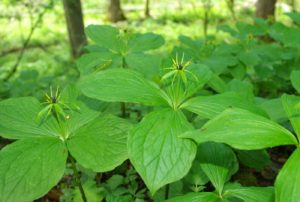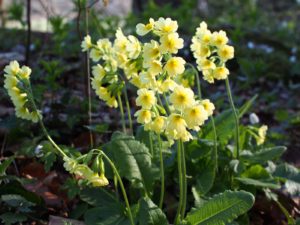5. In the species-rich beech forest
The flat northern side of the Ölberg is covered by a species-rich beech forest. Big oaks are growing along the edges of the forest. In contrast to the southeast side, the soil is deep and permeable for roots. The orientation to northwest produces a more balanced inner climate in the forest since the temperature peaks of the direct solar radiation are missing. Especially in spring and in the early summer time, it is worthwhile looking in the rich herb layer. In the more humid area of the hollow between the Ölberg and the Urberg, spring starts with the abundant flowering of the Primular Elatior. In the higher reaches of the slope you can find the Paris Quadrifolia with its noticeable constellation of four leaves and the single black berry. At the end of May, you can see, in the centre of the slope, the splendid Turk’s-cap lilies on the edges of the paths, if they have not been nibbled by the numerous deer which prefer them. By the way, none of the mentioned plants is ideal for a bunch of flowers and, additionally, they belong to the protected plants.
The beech forest is not only habitat for beautiful plants, but for many breeding pairs of woodpeckers, too. At the last count, a few years ago, there were five occupied breeding cavities of the spotted woodpecker, one occupied breeding cavity of a Black woodpecker, one of a Grey woodpecker, three of Green woodpeckers, two of Middle spotted woodpeckers and two of Lesser spotted woodpeckers. Well, it is quite understandable that you nearly get deaf ears because of the woodpecker’s clickety-clack.


